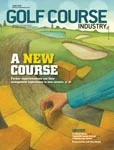I once wrote a column on maximizing the value of your annual trek to the Golf Industry Show. I’m a believer in the value of going to industry conferences to get a better idea of what’s going on and improving your skills. My grandfather always noted that the happiest people are the ones who keep learning and keep challenges out in front of them. So I should be a happy camper this month – I’ve been to a few educational opportunities recently.
In April I attended my state’s American Society of Landscape Architects meeting, where seminars covered various “nuts and bolts” topics, like designing better concrete cart paths and numerous ideas on how to make my designs “greener.” I took some CAD training and I’m scheduled for some more later this month. I just got back from the 63rd Annual Meeting of the American Society of Golf Course Architects. I became a member in 1981 and have attended 24 out of 28 meetings since then. I always learn a lot from sitting around with the best in the business.
I get a good sense of the state of the industry, which is currently grim. I’m one of the few architects designing a new domestic course. Some architects have remodel work, and others have international work, but as a group, we make the Maytag repair man look busy. If things don’t pick up next year, we might change the symbolic ASGCA blazer from tartan to burlap. (Grandpa also said you need to maintain a sense of humor.)
The main focus is continuing education seminars. While some of these look a lot like golf rounds at significant courses that can teach us about design (I played all four courses at Bandon Dunes and Chambers Bay), there are also classroom-type seminars, which updated me on some industry initiatives that affect superintendents and club members as much as architects.
The first initiative of interest to superintendents was an update to the GCSAA and Environmental Institute for Golf’s survey on current water and environmental practice. Ironically, the first e-mail I read when I got home was a plea from my local superintendents association to participate in the ongoing environmental surveys to document where golf courses are right now in improving their environmental performance.
Both ASGCA and GCSAA leaders recognize just how important it is to collect accurate data concerning what superintendents are doing now to create new models and technologies for water conservation and ecological performance. Real data about how each course is improving its performance may very well make the difference in perceptions about the role of golf in our lives and the environment.
The report notes how much progress has been made in reducing water and chemical use. Those kinds of facts have been useful to golf course architects making presentations to get projects approved, but as more courses fight water restrictions, club members, managers and superintendents will be making similar presentations more frequently. It’s very important for all courses to participate in this endeavor, even when the facts aren’t flattering – like the fact that many courses have actually used newer, water efficient irrigation systems to increase irrigated turf areas rather than cut the water bill.
The second important industry initiative is the USGA museum’s new golf course architecture archives, which will preserve the history of the game’s legendary architects and courses by archiving course drawings, field sketches, aerial photographs and other documents related to design. While they’re archiving the most historically important courses first, eventually they’d like information on most courses in America.
While preserving golf course architecture history is a passion of mine for obvious reasons, it’s important for every course to know its history. Besides being inherently interesting to members and many others, it also can benefit you as you remodel the course to know the agronomic and design history of your course.
I recommend that you safely archive your own documents, plans and also seek out all old photos, using the Internet as a research tool. Starting now, you should photographically document your course since it evolves slowly over time. If your golf course architect or his associates are still alive, have them visit for a day to hear and record the story of how your course came to be, either originally or in a previous renovation.
You’ll learn a lot and have fun researching your course’s history. And, someone will thank you for it someday, even if you don’t make it into the USGA museum. GCI

Explore the June 2009 Issue
Check out more from this issue and find your next story to read.
Latest from Golf Course Industry
- Editor’s notebook: Green Start Academy 2024
- USGA focuses on inclusion, sustainability in 2024
- Greens with Envy 65: Carolina on our mind
- Five Iron Golf expands into Minnesota
- Global sports group 54 invests in Turfgrass
- Hawaii's Mauna Kea Golf Course announces reopening
- Georgia GCSA honors superintendent of the year
- Reel Turf Techs: Alex Tessman





